Original URL: https://www.theregister.com/2013/08/02/kites_drafted_into_the_war_on_coverage/
Base stations get high on helium, ride MUTANT kite-balloons at the football
Wheeee... coverage, squeal Euro boffins
Posted in Networks, 2nd August 2013 08:29 GMT
A team of European boffins has hoisted a mobile network base station into the air from a balloon/kite combination. Yet unlike similar schemes, this one is intended for everyday use, not just for emergencies.
In a paper published by Cornell University, the team demonstrates that modern small cell technology can be combined with existing low altitude platforms (in the shape of a helium balloon with a kite strapped to the bottom) to create a stable radio network to provide extra coverage for special events.
While most schemes have focused on emergency relief and relaying broadband internet, the helikite-based system is intended to supplement existing LTE networks to provide coverage during big events like football matches, music festivals, or even in overcrowded places like London train platforms.
Attaching cellular base stations to balloons was old news way before Google made it trendy.
When it comes to balloons, the benchmark is the Space Data Corporation, which has been using weather balloons to provide broadband internet access across the southern US for years. Google was even seen sniffing around Space Data back in 2008, before the search giant decided to go it alone last month.

In the air, or on the ground, it still looks pretty silly
But Space Data has to pay a squad of volunteers to recover the drifting base stations, which only last a day or so ... and Google's Project Loon will need something similar. In contrast, Helikites are tethered over a specific venue and can be left in place for days if conditions permit.
The Helikite design - a kite strapped to a helium-filled balloon - is owned by Brit Sandy Allsopp and it's not the first time they've been suggested as a communications platform. A Helikite has more lift than its size dictates, and the inventor promotes them as a radio platform among other things. It’s the integration with existing networks which makes this development significant.
Small cell technology, as used in domestic femtocells, puts a lot of intelligence into the base station. A small cell will know the range of frequencies available to its owner (the network operator) and is able to scan those frequencies to detect - and interact - with the macro network to allow handoff between cells. Put that technology into a <10kg package and strap it to a Helikite and network capacity jumps up with the minimum of fuss.
It's not quite that simple, of course, but the paper (PDF, page 5 - tough but the rest is quite intelligible) runs though the pros and cons of such an approach.
Everyone seems to be gazing skyward for connectivity these days, given the expense of laying fibre optic cables and the latency inherent in reaching all the way to orbit. But it's hard to see how kites or balloons can be anything but a stop-gap solution while we wait for proper connectivity to arrive. ®